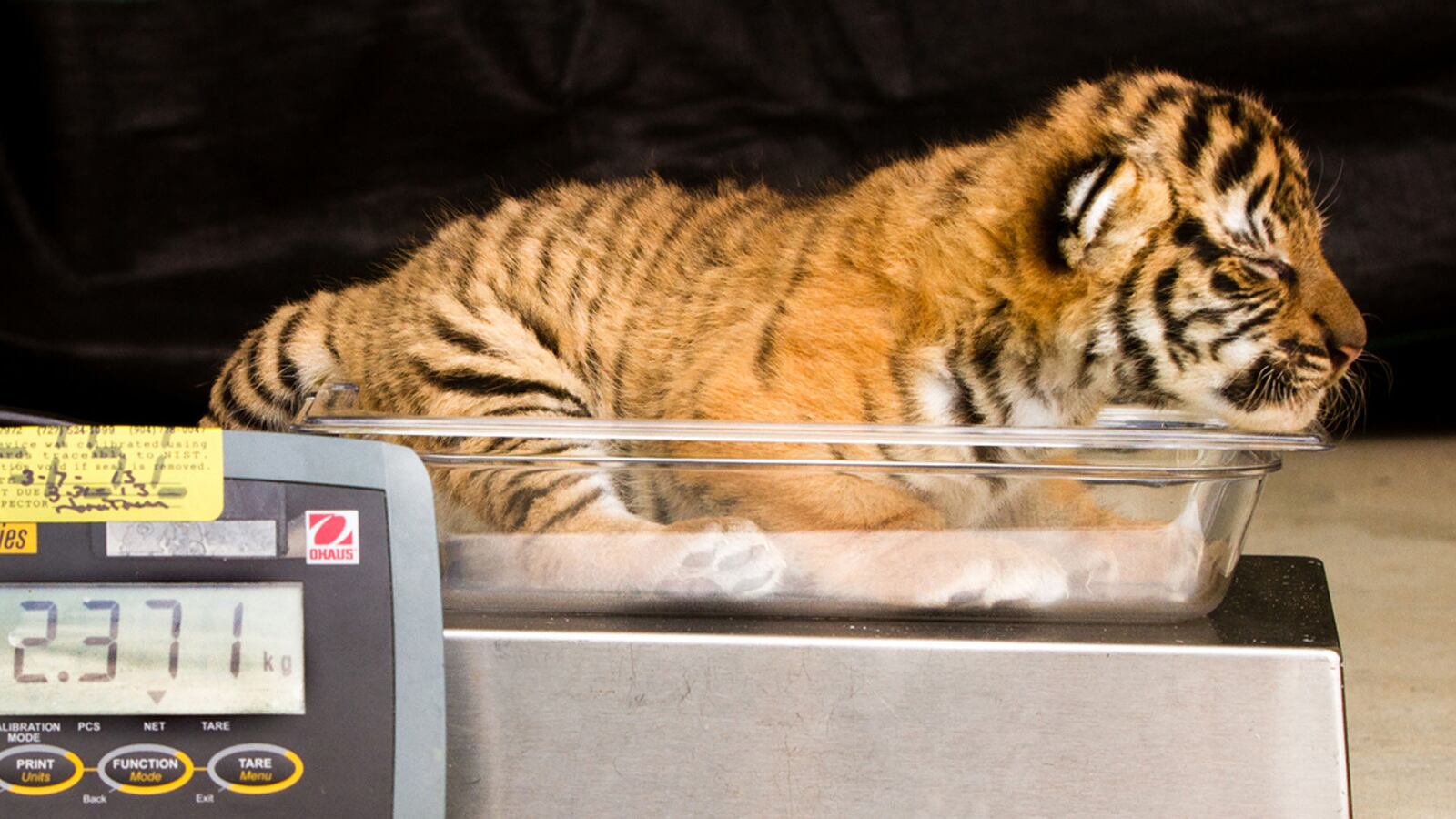There are currently over 1,200 species of animals listed as endangered or threatened, and those are only the ones we know about. Some as yet undiscovered may well have disappeared between the time we lit the birthday candles and, appropriately, blew them out.

To make a small difference, the Endangered Species Coalition suggests you visit a wildlife refuge, help prevent the millions of deaths each year of birds colliding with windows by affixing decals to yours, slow down while driving to avoid turning the berm into any more of a wildlife cemetery than it already is, or stop dousing your lawn with chemicals. You could also depress the heck out of yourself by watching the 2010 documentary Call of Life, in which eminent scientists predict that a mass extinction of over half of all plant and animal species is likely before the end of the century. My recommendation, though, is to read Wild Ones: A Sometimes Dismaying, Weirdly Reassuring Story About Looking at People Looking at Animals in America, Jon Mooallem’s stupefying account of our historic inability to stop meddling with everything under the sun. We bring masses of creatures to the brink of extinction, then expend perverse amounts of energy and ingenuity to haul them back, one by one. “Dismaying” is right, and “reassuring” sounds like it came from the marketing department, while "brilliant in conception and execution" would belong with these if only the subtitle weren't stuffed enough already.
The author, a contributing writer for The New York Times Magazine, gives only a brief history of the act signed into law 40 years ago (“Nothing is more priceless and more worthy of preservation than the rich array of animal life with which our country has been blessed,” opined President Nixon, pen poised), because his main subject is instead the bizarre gymnastics we have sometimes performed to uphold it. He uses three examples—the polar bear, Lange’s metalmark butterfly, and whooping cranes—to explore our confounding and contradictory relationship to the brethren species with whom we share the planet, though apparently we share the way toddlers do with sandbox toys. All three of these endangered species are charismatic, awing us with the kind of aesthetic endowments lacking in, say, the plain-looking Helotes mold beetle, or the atyid shrimp (“off-brand animals,” in the author’s sly term). They call forth our most conflicted response, the better for Mooallem to display and dissect.

When Europeans first landed in the New World, the animals of the continent were so profuse, we could not imagine them otherwise, although we wanted to. Wolves, bears, and cougars were the massed enemy on the hill, and our stories were of their unbridled ferocity. Thomas Jefferson, for one, had believed that “no instance can be produced of [nature] having permitted any one race of her animals to become extinct.” But when we finally cracked some links in the Great Chain of Being, the morals reversed. As soon as the grizzly bear “disappeared from the land, it found new prestige in our imaginations,” Mooallem writes, and his book is truly about the animals of our imaginations, because it is their status there that will lead us either to eradicate them or to save them. Or both at the same time: since 2007 11 whooping cranes—of a population of fewer than 300 laboriously nursed into existence from the small handful left alive in the 1940s—have been found shot. In 2011 a Minnesota farmer smashed thousands of eggs and young chicks of the federally protected American white pelican.
As a carnivore that naturally ranges over vast territory, the polar bear does poorly in captivity, developing stereotypies, or compulsive behavior—think Gus, “the bipolar bear” of the Central Park Zoo, ceaselessly swimming the same circuit of his small pool. Now they’re doing poorly in the wild, too. They are dying from starvation, as the ice caps on which they hunt form later and melt earlier due to climate change. A conservationist estimates that the waters of the Hudson Bay at Churchill, Manitoba, will stop freezing entirely by 2050, dooming one of only 19 polar-bear populations on the planet. That is why it has become a favorite stop on the “last-chance tourism” train. Mooallem visits at the same time Martha Stewart does, although she proves more elusive than any of the bears. It is one act in the theater of the absurd that Wild Ones presents in all its prodigious eccentricity, but by no means the most outrageous. It is hard to say which of the increasingly nutty episodes in man’s tortured relationship to his own conception of wildness here is the most outlandish; page by page they mount. You can only stand back and gape. (Only rarely do the animals have the last laugh, as do 3 1/2 million Canada geese today. In 1962 only a single flock could be found, which was prayerfully coddled, fed, raised, and reintroduced. Now they are so abundant that they have to be shot, gassed, eggs scrambled in shell, and chased away by eager border collies.)
Butterflies, the stuff of so many glitter stickers and ankle tattoos, are nature’s airborne art. They seem to capture a sense of ephemeral life at its most impossibly beautiful, so our sadness at the prospect of losing even one of the approximately 20,000 species of butterflies known to exist is understandable. What is not is the contortions a few governmentally supported conservationists (along with a host of concerned, or obsessed, volunteers) must execute to preserve a tiny remnant of Lange’s metalmark butterflies in the small, grotesquely compromised habitat of the 67-acre (55, says the government website) Antioch Dunes National Wildlife Refuge. The sand dunes were relentlessly mined in the past century; power lines and a gypsum plant split the park. In 2006 only 45 of the orange-and-black butterflies could be found, down from thousands a decade before. They lay their eggs only on naked-stem buckwheat, which is being overrun by invasive hairy vetch that has to be pulled out by hand or herbicided to death, with predictable fallout—namely the harming of butterfly eggs. Attempts to maintain a viable habitat this isolated are dubbed conservation reliance and are at once comedic and tragic, a strange opposition balletically explored here. They illustrate the phenomenon known as island biogeography. As David Quammen described in his elegiac The Song of the Dodo, islands are “where species go to die.” But as Wild Ones shows, they’re not going down without a fight, even if it is a futile one, and involves lots of grad students with plastic cups and captive female butterflies.
When finally we read of whooping cranes reared by humans in costume, taught to migrate behind men in ultralights, and shoved away—pepper-sprayed, in fact—from food sources deemed insufficiently wild, the question can no longer be avoided: for whom do we do this? Probably not for the bird who has just been gassed “to promote wildness.” Such efforts—“heroism in the Sisyphean sense”—seem to be made primarily for us humans, so we can write a bedtime story that contains man and animal intertwined, exchanging nobilities.
This book is dense with both thought and fact, but no one will mistake it for an article in the journal Biodiversity. It is written with a vernacularly light touch, shot through with compassion and wit, not to mention open amazement, the only apt response to the story of our monumental hubris.
Zoom out, and what you see is one species—us—struggling to keep all others in their appropriate places, or at least in the places we’ve sometimes arbitrarily decided they ought to stay. In some places we want cows but not bison, or mule deer but not coyotes, or cars but not elk. Or sheep but not elk. Or bighorn sheep but not aoudad sheep. Or else we’d like wolves and cows in the same place. Or natural gas tankers swimming harmoniously with whales. We are everywhere in the wilderness with white gloves on, directing traffic.
Busy though we may be in ecology's intersection, look out. Some big trucks approach. They appear to have no brakes.






